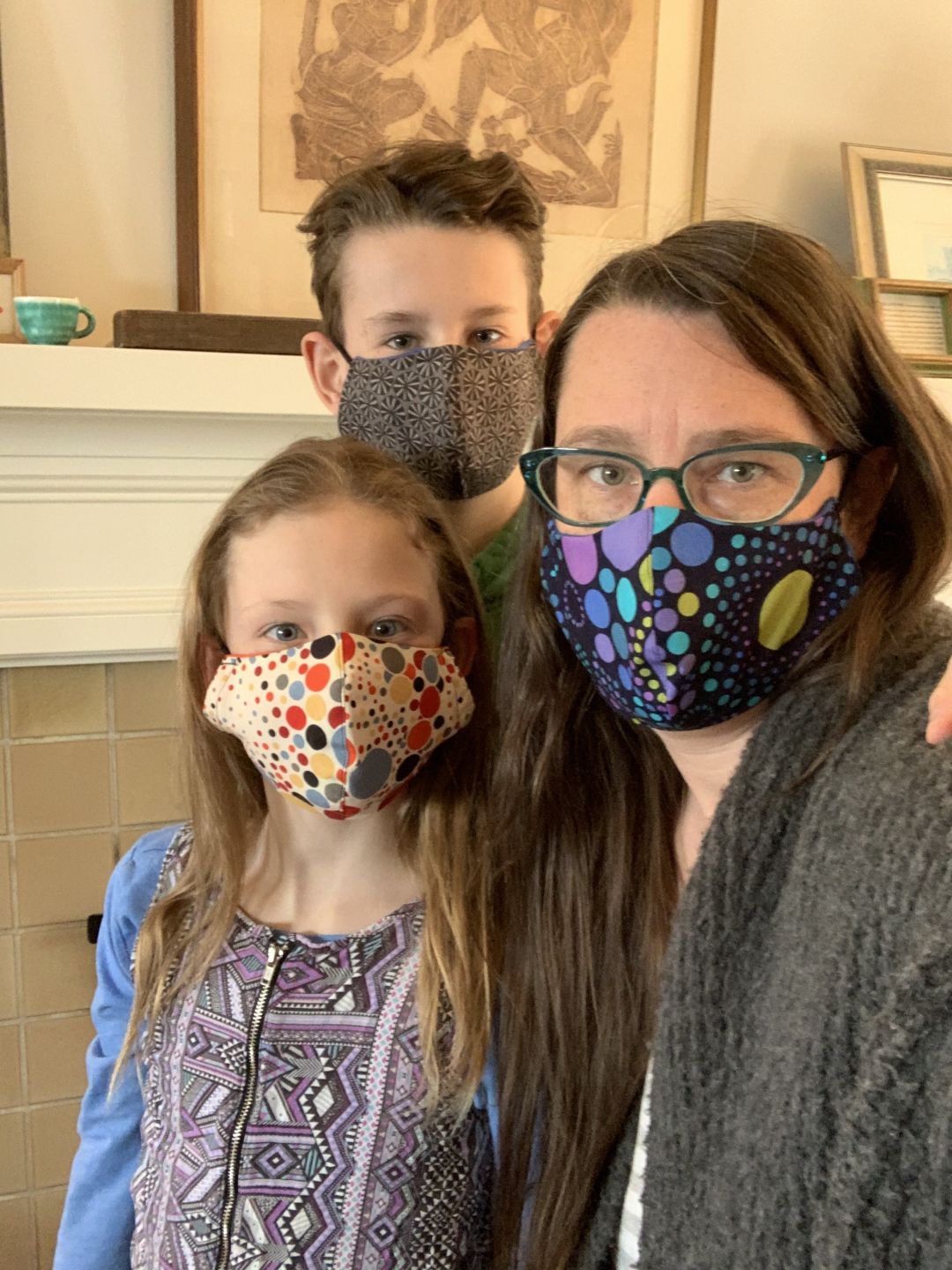To Combat Medical Gear Shortage, the Home Sewing Army Steps Up

Margaret, Eliot, and Sharon Weir of Southeast Portland model their homemade masks.
Image: Courtesy Sharon Weir
A week ago, Anne Jin couldn’t have predicted she’d have to explain to a stranger on Facebook that it was inappropriate to cut up their yoga pants to sew a mask for a COVID-19 patient, and that said mask should under no circumstances be secured with pipe cleaners.
But these are the times in which we are all suddenly living, and so Jin, a teacher by trade whose husband is an infectious disease physician at a Portland hospital, finds herself managing a mushrooming group of 7,000 would-be mask sewers, many of whom have both the best and kindest of intentions and a seemingly insatiable need to bicker over whether a duckbill or pleated pattern is the morally correct choice for a home-sewn mask.
Her new motto, she says, is “Keep calm and make masks,” and after some fits and starts that is just what the members of her week-old Facebook group, Crafters Against Covid-19 *PDX*, are doing.
And they are not alone. All over the internet, home sewers are joining groups, trading tips and stitching up homemade masks in an attempt to fill the gap left by severe shortages of personal protective equipment, including masks, gloves, goggles, and hospital gowns, in hospitals around the world.
In Portland, masks made via the Crafters Against Covid-19 group will be used not by medical professionals but by patients who are crowding hospital waiting rooms and showing symptoms of coronavirus and by immunocompromised patients getting care in infusion centers and other hospital-based settings. Other groups are working on masks for grocery store employees, gas station attendants, and other essential workers who can’t stay home. The common goal: free up precious medical-grade masks for use by health care workers.
Jin’s effort started modestly, when her husband came home last Wednesday and told her he was frightened by the dangerously low supplies of protective gear on hand; around the same time, Gov. Kate Brown announced Oregon had only about two weeks of supplies on hand, with stockpiles rapidly being depleted. (Since then, donation points have sprung up around the city and the state and industries from nail salons to construction workers to the Intel Corp have pitched in; Brown announced Tuesday that Oregon was getting a shipment of personal protective gear from the federal government, though only about a quarter of the total that the state had requested.
“He said, ‘You’ve got a sewing machine. Start making masks,’” she says.
It would be a project to do with her homebound kids, Jin thought, and so she put out the word, first on her kids’ school’s Facebook page, and then to the network of doctors she knows, sharing some simple YouTube tutorials they’d found online.
Interest was immediate, and it didn’t take long to figure out she’d need to start up a dedicated Facebook group to act as a central hub. By the time she put her son to bed on Thursday night, the group was at 1,300 members; the next morning, it had grown to 1,800.
With such quick growth came a bit of chaos, as eager helpers tried to sort through conflicting guidance about which fabrics could safely be used and how to safely get donated masks to their intended recipients.
So Jin, and her group’s three other quickly acquired volunteer moderators, swung into action. By the weekend, they’d connected with Multnomah County public health officials and gotten firm guidance on what materials home sewers should be using. For the record: All fabric should be new, unused, breathable and tightly woven, such as 100 percent cotton, quilting cotton, or cotton flannels. Masks can be secured with elastic or—in a real pinch—cotton twill tape.
That means—and sorry to those who asked Jin about yoga pants or the heels of their socks—no vintage, stretchy, knit, used towels, sheets, or clothing, no metal, plastics, filters, or vacuum bags, and no hair ties or rubber bands for the ear loops. (A simple tutorial is here.)
At first, Jin had thought she’d be able to have donated (and laundered) masks dropped off at her doorway and could send them to her husband’s workplace. But that plan quickly became untenable, and now home-sewn masks should be placed in a clean bag, then sealed in a box, and labeled with the contents. Donations can be dropped off at the Multnomah County Building between 9 a.m. and 4 p.m., Monday–Friday, and will be redistributed to local hospital systems.
After all that, Jin says she and her kids have not yet had a minute to make any masks themselves, but it’s in the works. Meanwhile, hundreds, or even thousands, of other home sewers have gotten to work.
“At our house, I have been struggling to feel productive or useful or much of anything other than to be in pajamas and to stay in bed,” said Sharon Weir, a teacher at Northwest Academy who has been making home masks with her children. “But when given an opportunity and encouraged by so many people, I thought, ‘I can do this. We can do this. This is important.’”
“You also said, ‘Finishing Harry Potter is not as important,’” chimed in her daughter, Margaret Weir, 10.
“Not as important as making masks to save lives,” her mother agreed.




